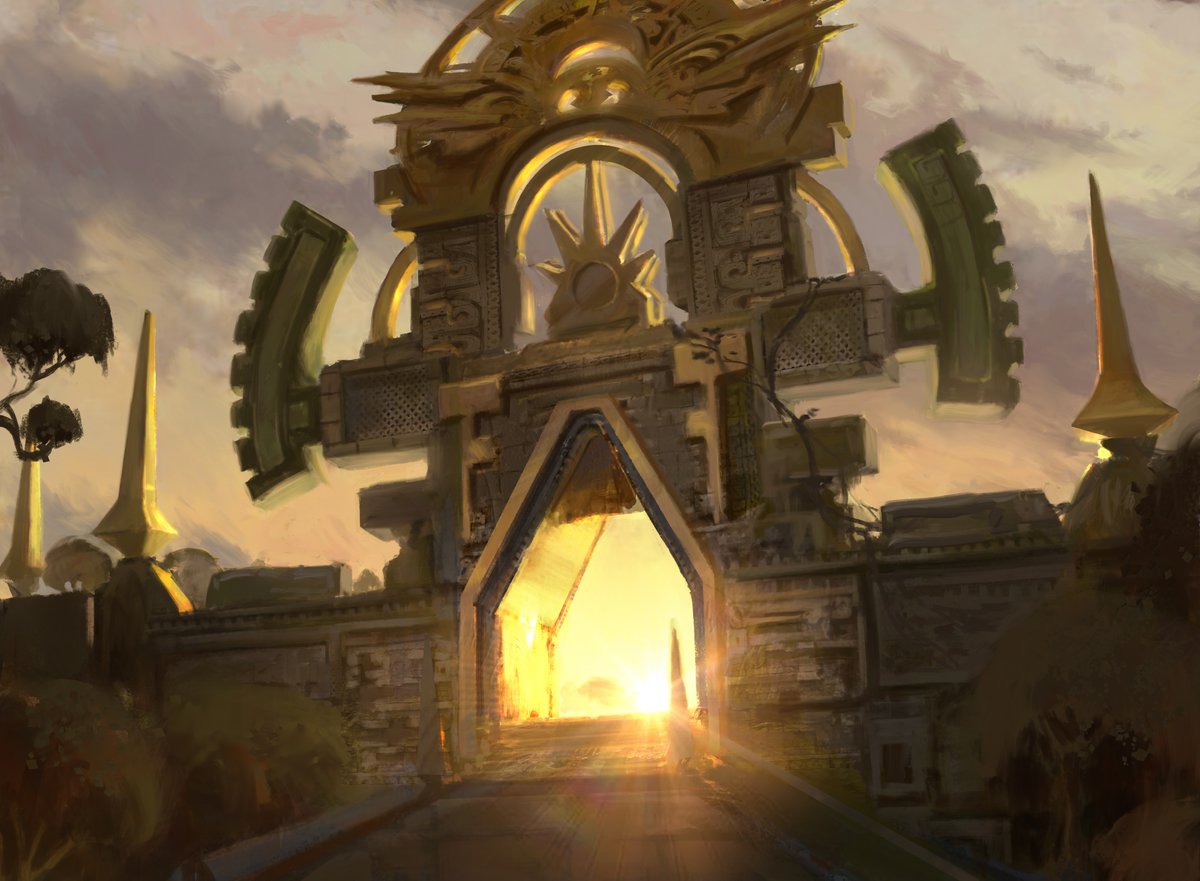Are you a Quiet Speculation member?
If not, now is a perfect time to join up! Our powerful tools, breaking-news analysis, and exclusive Discord channel will make sure you stay up to date and ahead of the curve.
Earlier this summer, I hosted a homemade tournament with seven friends. Grand Prix Bristol, as it was dubbed, consisted of three different draft formats: Modern Masters 1 (MMA), Time Spiral Remastered (TSR), and Kamigawa Neon Dynasty (NEO). We selected the formats democratically, drawing from the reserves of draft sets we had accumulated over the years. Excitement bristled as we counted down the days to the event.
The play was competitive, the attitudes were positive and respectful, and merriment was had by all. Overall, the event was a blast and is destined to become an annual tradition. It united old friends and even had a hint of high-stakes, as a "trophy" was purchased to crown the GP Champion.
If you take one thing away from this article, it should be that events like this are worth having. They can be difficult to organize, but they are worth that investment. Moreover, the event brought up a number of lessons that I was able to use to navigate these three formats. Every draft has a story and there were several to learn from throughout the course of the day.
Draft #1: Modern Masters
MMA is a format driven by ten streamlined archetypes but littered with powerful individual cards. Regrettably, I didn't open a bomb, but I had the wherewithal to navigate the format with patience. My first five picks spanned all five colors. By collecting a number of good cards, I felt prepared for whatever pathway opened up before me.
Equilibrium Theory
I have a theory about draft, but it's largely untested.
Oftentimes, I feel like there is a disconnect between the perception of decks being good and/or bad and the actual success rates of these decks. Additionally, I believe that this discrepancy emerges far more often when players play in pods.
There are multiple reasons why someone might believe they have a strong deck, but the most common one is that the colors were open. When our colors are open, that leads to passing good cards of other colors to players who are clearly not drafting the same colors, synergies, or strategies we are. We get the cards we want, but our opponents get the cards they want as well.
In short, if our colors are open, it is very likely that our neighbors are enjoying the same experience from their seats. If we find ourselves battling it out over an archetype, we also send mixed signals for our neighbors to decipher. It's rare for a draft to have one player with a great deck, surrounded by multiple bad ones. While the outcome will never be perfectly equitable, it's good to keep in mind that if the draft was hard, it was probably hard for everyone else at the table as well.
Five picks into my first draft, I didn't know my colors, but I heard voices from around the table echoing a similar sentiment. In the first few picks of pack two, I started moving towards a white/black deck, and I committed by the start of pack three. Judging by the table talk, the rest of the table also appeared to settle in by this point.
Know the Archetypes, Find the Archetypes, and When Necessary, Blend the Archetypes
I intentionally avoided red-white Giants, passing multiple Thundercloud Shaman. I have a vague memory of this archetype, being one of the weakest in the format. If I was supposed to be in the deck, I would determine that by evidence found later in the pack.
The strongest card I saw was Divinity of Pride. In pack one, I surrounded it with some mediocre removal and Rogues, though black-white really wants to be in Rebels, and Divinity of Pride really wants to be in black-white. Those colors were contested, but nothing else seemed particularly open. Packs two and three yielded more Rebels, and my deck ended up something of a hybrid. It had a small Rebel package, decent removal, some powerful Rogues, and a single Avian Changeling to tie the room together.
The Deck
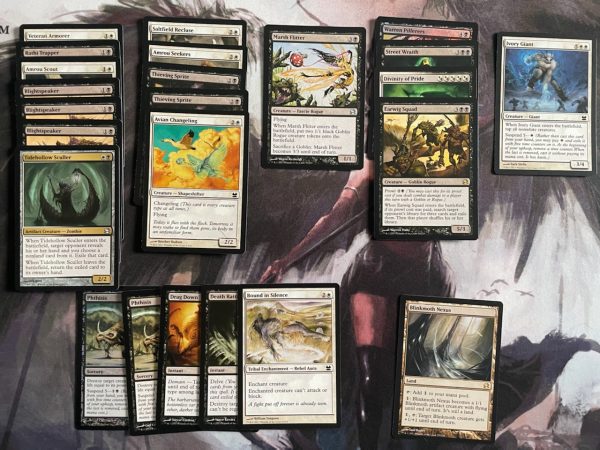
BW Rebel-Rogues
My deck was solid but not great. Avian Changeling was the MVP, as it was an evasive creature that I could tutor out with my Rebels, and a Rogue that could activate the prowl on Earwig Squad. More Rebels would have been nice, but I went 3-0 in the draft, miraculously beating a Sword of Light and Shadow in the finals (which my opponent played all three games).
Though I eventually found an open archetype, I had to get very creative to complete the deck. It wasn't truly a Rebel deck, it wasn't truly a Rogue deck, but it utilized overlapping synergies well enough to 3-0.
Draft #2: Time Spiral Remastered
After going 3-0 in MMA, I fixed my sights squarely on the trophy. I've never drafted Time Spiral Remastered (TSR) though, so I was headed into the format completely blind. My first pick was difficult, but I settled on Arch of Orazca. This card kept me open and could be a source of card advantage. Because the original Time Spiral format was so dated, I assumed having a resource of this nature would be valuable. My second pick was a Dismember which further kept me open, though I was looking to be in a more controlling shell.
I found very good green cards to pair with my first picks and this provided a direction. Blue was clearly open towards the end of the pack, so I paired the two colors and began building a strong deck. While I wasn't sure of the format's nature, the deck I was building had a direction. Simply put, the plan was to overrun my opponent with an onslaught of value creatures. This archetype found some payoffs in Beast Whisperer, Aeon Chronicler, and two copies of Magus of the Future. I assembled a pile of above-rate creatures capable of drawing my entire deck.
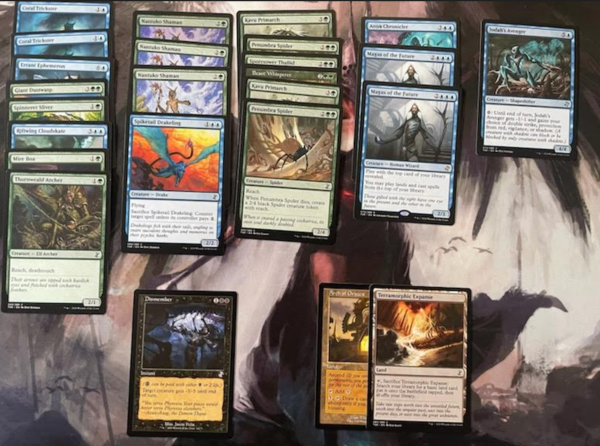
G/U Creatures ft. Dismember
Rely On Macro-Archetypes In Unfamiliar Metas...
This deck looked like a success. Not only was I in open colors, but the table opened really strong green and blue cards in packs two and three. One of the first rules of Draft is to always have a plan. Each format provides its own premium archetypes and rules of engagement. We've talked about formats where control decks are unreliable and ones where certain colors should be heavily prioritized. However, the absence of this information should never equate to the absence of a plan.
Building an aggressive deck, relying on card advantage and removal, or ramping into powerful endgames are all examples of macro-archetypes. Usually, the cards that make them work will be available in a given draft format. This framework can help you find a deck that makes sense, though if you find two open colors with strong card quality, you will probably thrive regardless.
...But Knowing the Format is a Real Advantage
My first loss was a decisive one. It came in the second round of the second draft and ended in a swift 2-0 against an awesome black-white aggressive deck. Even though I specifically stocked my main deck with two-drops to interact on this level, my ignorance of the format was exposed. My opponent's flanking creatures made light work of my Mire Boa and Coral Tricksters. Knight of the Holy Nimbus and Benalish Cavalry paired with well-timed removal spells to knock me out. When I thought I stabilized in game two a Crovax, Ascendant Hero came out of nowhere to decimate my blocks. Tough beats, but you can't win them all.
My opponent had a better understanding of the format than most of the table. He had brought the packs and drafted the format previously. While I had a fine strategy and good cards to execute it, knowing the way interaction stacks up in the format and the over-performing cards and archetypes proved to be very valuable.
I Salvaged a 2-1 out of this draft after sideboarding in a Crookclaw Transmuter to help me get through a Stuffy Doll in my third round opponent's Sliver deck. Still, at 5-1 on the day, I needed to 2-1 the next draft to guarantee the trophy. A 1-2 finish could lead to a tie. This is where things took a turn for worse.
Draft #3 Kamigawa Neon Dynasty
Of all the day's formats, this was the one I knew best. I'm familiar with all the archetypes and am happy to play any of them. When I saw my first pick I was ecstatic. Brilliant Restoration is a card that I wanted to draft around when I first saw the set. On Arena, I had gotten a chance, and I pieced together one for the ages.
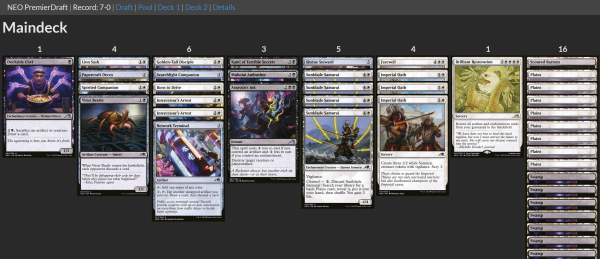
Recreating this deck to lock up the trophy became my one and only goal. Nothing could be more perfect, so I moved forward with my plan. Unfortunately, my desperation to recreate the past led me astray.
Brilliant Restoration Might Not Be The Bomb I Thought It Was
Past Performance Does Not Guarantee Future Outcomes
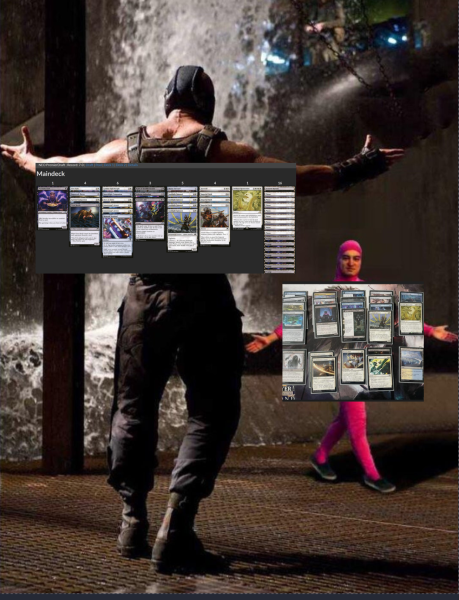
Over-committing to my first pick was a huge mistake. I should have been in a UR artifacts deck, which was very clear when I tabled an Enthusiastic Mechanaut pack three. I felt the error of my ways in round one. My first opponent also played a black/white deck, however, his featured a much stronger and more aggressive card pool. Soundly defeated, I was unsure how my deck could win a single game in the ultimate draft. I had few creatures and my strategy was extremely inconsistent.
Be Clear, Focused, and Purposeful
After a grueling day of Draft, my brain was fried. Conversely, my next opponent, piloting a very unique green/blue ninjas deck, was exceptionally sharp. He communicated his actions clearly and played purposefully. A long day had taken its toll and I was struggling to even keep track of my land drops. When I did take my time, I felt lost in the permutations of each individual play, struggling to find the right line. I would be lying if I said I never felt this way in the closing rounds of a real GP.
Game two against the ninjas player was a slog that I was able to win because of my two most powerful cards. Brilliant Restoration and Inventive Iteration took over and I was able to ride them to force game three. In our final game, I was able to take a controlling position, and my opponent flooded out. I did not play particularly well in this round but was lucky to come away with the win.
However, in round three I did my best to emulate my previous opponent's professionalism. Stealing that win reinvigorated me for this final battle. Against my final opponent's aggressive red/white deck, Wanderer's Intervention bought me the time I needed and I was able to draw the best parts of my deck to win in two straight games.
While I don't like to dwell on softer skills in my articles, I'm compelled to recognize this one. Communicating your actions clearly helps organize the minutia of the game. Magic: the Gathering is a complicated game. Deliberate communication helps us navigate and process those complications. I salvaged this draft because of what I learned in round two. Had I continued to play on auto-pilot, I would not have been able to walk away as the champion.
To Make A Long Story Short, I Bought Myself a Playmat

Winning my own trophy felt wonderful but not nearly as wonderful as spending a day with good friends playing great games. Furthermore, jumping feet-first into a bunch of random formats for a (sort of) legitimate prize was a great experience. I hope you find these reflections valuable as you strengthen your own game. If you have the space and a group of friends I strongly recommend hosting an event like this. It was one of the highlights of my summer and I look forward to doing it again.


